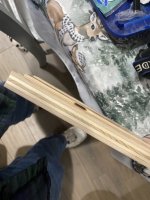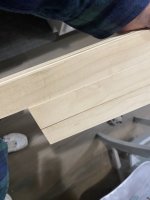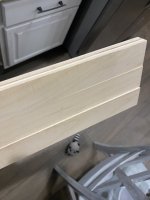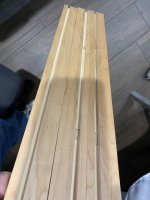Festdewalkita
Member
- Joined
- Oct 9, 2020
- Messages
- 49
I will be attaching hardwood to cover the edge of plywood. The pieces are notional 3/4" ply wide (roughly 18mm) by 3/4" deep. I was practicing on thin strips of plywood on the off-chance things didn't go well.
I'm plunging like I've seen done in countless videos--following the 4 rules of Domino-ing. I'm getting crooked faces:
View attachment 1
View attachment 2
View attachment 3
View attachment 4
It's outside its warranty (I just didn't get on my projects like I thought I would and barely used it during its first 3 years...but at least I got it before they further devalued the dollar--yay).
I'm really at a loss as to what operator error might be involved. Page 26 of the supplemental manual has "Plunging too slow can cause the mortise slots to be tilted slightly."
The slots are not obviously tilted, so does that leave a non-perpendicular plunge as the most likely culprit? Flexing in the material?
Does anyone have any experience with this problem? If so, how did you solve it?
Is it jig-building time (so that the Domino's fence has more from which to register)? Domiplate + Seneca "The Dock" time?
I'm loathe to plunge into the actual materials until I solve this (it was the whole reason I bought the darn thing) and would hate to just go buy a doweler...but this project's time has come and I can't wait too long to figure out what's wrong.
Thanks in advance for any tips.
I'm plunging like I've seen done in countless videos--following the 4 rules of Domino-ing. I'm getting crooked faces:
View attachment 1
View attachment 2
View attachment 3
View attachment 4
It's outside its warranty (I just didn't get on my projects like I thought I would and barely used it during its first 3 years...but at least I got it before they further devalued the dollar--yay).
I'm really at a loss as to what operator error might be involved. Page 26 of the supplemental manual has "Plunging too slow can cause the mortise slots to be tilted slightly."
The slots are not obviously tilted, so does that leave a non-perpendicular plunge as the most likely culprit? Flexing in the material?
Does anyone have any experience with this problem? If so, how did you solve it?
Is it jig-building time (so that the Domino's fence has more from which to register)? Domiplate + Seneca "The Dock" time?
I'm loathe to plunge into the actual materials until I solve this (it was the whole reason I bought the darn thing) and would hate to just go buy a doweler...but this project's time has come and I can't wait too long to figure out what's wrong.
Thanks in advance for any tips.




